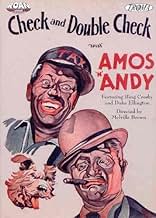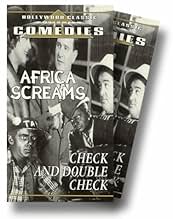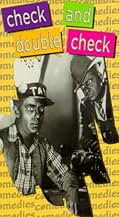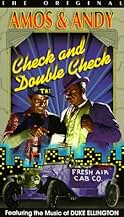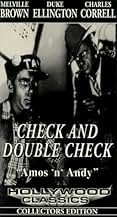Ajouter une intrigue dans votre langueTypical Amos 'n Andy storyline has the boys trying to make a go of their "open-air" taxi business while they get caught up in a society hassle, involving driving musicians to a fancy party. ... Tout lireTypical Amos 'n Andy storyline has the boys trying to make a go of their "open-air" taxi business while they get caught up in a society hassle, involving driving musicians to a fancy party. All the regular characters are here (or mentioned), including the famous Mystic Knights of... Tout lireTypical Amos 'n Andy storyline has the boys trying to make a go of their "open-air" taxi business while they get caught up in a society hassle, involving driving musicians to a fancy party. All the regular characters are here (or mentioned), including the famous Mystic Knights of the Sea. The only film appearance of radio's long-running characters.
- Réalisation
- Scénario
- Casting principal
- Récompenses
- 3 victoires au total
- Richard Williams
- (as Charles S. Morton)
- Elinor Crawford
- (as Rita LaRoy)
- Brother Arthur
- (as Rosco Ates)
- The Cotton Club Orchestra
- (as The Cotton Club Orchestra)
- Akim Tamiroff
- (non crédité)
- Member, Cotton Club Orchestra
- (non crédité)
- Member, Cotton Club Orchestra
- (non crédité)
- Member, Cotton Club Orchestra
- (non crédité)
- Angry Policeman
- (non crédité)
- Policeman
- (non crédité)
- Member, Cotton Club Orchestra
- (non crédité)
Avis à la une
Now of course, in "Check and Double Check" Amos and Andy are played by two guys in blackface, the two white guys who have made Amos and Andy famous up until that point. It is very funny seeing the white guys in blackface, because there is no doubting they are indeed white men (Kingfish is white too). Seeing this film was especially interesting for me because I have the two Amos and Andy cartoons from 1934 (the only ones ever made) which use the voices of these two actors.
The movie itself is pretty good, Amos and Andy get mixed up in some society plot, involving some well-to-do white people from Westchester. Back in Harlem, the duo run their taxicab company, and there are some nice shots of New York City in 1930. And for train/subway fans, there is a particular treat, as we go into the original Pennsylvania Station for some shots! There are some funny scenes in the film, with Andy's deadpan lines making me laugh the most. Maybe the thing that would surprise most new viewers of this film, is just how much the actors underplay their roles as Amos and Andy as far as black stereotyping from the 30's goes. As all old film fans know, black actors in these old movies were usually put in for comic relief, making funny faces and noises, looking bug-eyed, running scared at the slightest sound, jumping around with arms flailing if they were scared, etc. But these two guys really don't do any of that. Sure, they play for comedy, but even though they are in blackface, they actually avoid all that kind of stuff, and just play the comedy straight. This may disappoint anyone looking to blast and tear the film apart concerning the two actors as Amos and Andy, but it's the truth, they really don't make an effort to make blacks look silly, they are really playing a comedy while happening to be in blackface.
Most don't understand just how huge the characters of Amos and Andy were in those days. This film is an unbelievable artifact of the era, an entertaining excursion into 1930's comedy. The quality of the print is also downright excellent on the DVD I viewed. I highly recommend this film for entertainment as well as historical study.
This is of course the infamous, original incarnation of Amos and Andy, with white actors Gosden and Correll in black face playing the leading roles. They aren't as mean spirited as some of the other caricatures of the time, but it's a sad sight, nonetheless. The decision was also made to have all other black characters with a speaking part also be white people in black face, although extras were cast with actual black performers. The nature of Amos and Andy is enough of a drawback, but what really killed this for me was that it is just not funny in the least. Actors like Willie Best and Mantan Moreland could often be hilarious despite the insensitive portrayal of their characters. But the comedy here is non-existent. The "old dark house" set-up seems tacked-on and unexploited for the inherent comedy, and none of the supporting players are very good at all, either. Gosden was said to have been unhappy with how the film turned out, and there were no other Amos and Andy features. This is surprising since the film was extremely profitable, and was the biggest hit in RKO's history until King Kong.
The movie does feature one stand-out scene of Duke Ellington's band performing some songs (even using Bing Crosby's voice for one). It raised the entire film's rating by one star, in my humble opinion.
The "Amos n' Andy" radio show held legions of fans for decades. The TV show is fondly remembered by tens of thousands who were lucky enough to see it. The reason for this is simple; they made people laugh. This movie, however, is a very poor example of the character's work.
The main thrust of the plot is an uninteresting love triangle between a wealthy heiress, her jerk of a rich boyfriend and an old flame who has lost his wealth and is seeking to reclaim it. Although the movie is a comedy, none of these three characters are in any way funny. Amos n' Andy are secondary characters in the story. This is the first blow to the story. Amos, Andy and the Kingfish carried their own stories for years, why should they play second fiddle to people we care nothing about? To make it worse, Amos n' Andy's involvement in the plot is painfully contrived. The plots of the radio and TV shows were smooth and sensible (for a comedy). They worked because they did not have to be forced. The plot of this movie, by contrast, seemed forced every step of the way.
Copies of the Amos n' Andy radio and TV shows are available for sale. If one is willing to track them down they will provide a clear picture of why the characters were so successful. This movie, by contrast, should be left to those who feel the need to own everything with the Amos n' Andy name on it.
Both of these folks will be delighted to take offense at the very mention of the name "Amos and Andy," whether they've ever actually SEEN any version of the show or not. A&A are the very SYMBOL of Hollywood racism, defaming the image of blacks. Supposedly.
I would take it that "Amos and Andy" represents (however accurately or not) a broadly caricatured representation of regular poor black folks. You could make it out to depict them as foolish, but no more so I say than do shows aimed at poor whites. I have in mind for starters the Beverly Hillbillies.
Nor are the depictions of Amos and Andy harsher than those of Ma and Pa Kettle. Now THERE is some negative stereotyping.
But hey! It's just a joke, and not particularly mean. Amos and Andy as characters aren't deep, but they're affectionate and good natured, just a couple of regular joes trying to get by. Doesn't strike me as much of a hate crime.
Oh, and they're pretty damned funny, too. Note that this bears the same screenwriter's name as several Marx brothers classics, Bert Kalmar. This ain't quite up there with "Duck Soup," but it's pretty funny stuff. The kingfish and the lodge stuff put me in mind of the Flintstones' "Water Buffalo" lodge, and the silly rituals and blowhard leaders trying to puff themselves up to look like alpha-males.
Also, this film stops for some straight up film time for the most righteous Duke Ellington orchestra. There is very limited film available for any musicians of the era, especially black ones. This part alone justifies the film's existence for me.
C'mon, loosen up folks. Eddie Murphy makes 10 times more stinging jokes. At least Amos and Andy weren't pimps or dope-dealers or crooks.
Le saviez-vous
- AnecdotesBoth actors who played Amos and Andy were white in what was known as "blackface" makeup at the time. Blackface had been mostly abandoned by mainstream American films by 1930, unless it was diegetic (i.e. characters are performers who wear blackface as part of their act). It was decided that all African-American speaking roles in this film would, for aesthetic continuity, be played by white actors in blackface; the only exceptions were Duke Ellington and his orchestra appearing in the party scene, and the occasional non-speaking extra in scenes set in Harlem.
- Citations
Lodge secretary: At da las' meetin' which was for da purpose of COLLECTIN' DA LODGE DUES, der was NOBODY PRESENT! Dat, gen'lemen, was da minutes of da last meetin'.
- ConnexionsFeatured in Amos 'n' Andy: Anatomy of a Controversy (1983)
- Bandes originalesThree Little Words
(1930) (uncredited)
Music by Harry Ruby
Lyrics by Bert Kalmar
Performed by Bing Crosby, Harry Barris and Al Rinker with the Duke Ellington Orchestra
Meilleurs choix
Détails
- Date de sortie
- Pays d’origine
- Langue
- Aussi connu sous le nom de
- Двойна проверка
- Lieux de tournage
- Société de production
- Voir plus de crédits d'entreprise sur IMDbPro
- Durée1 heure 17 minutes
- Couleur
Contribuer à cette page




